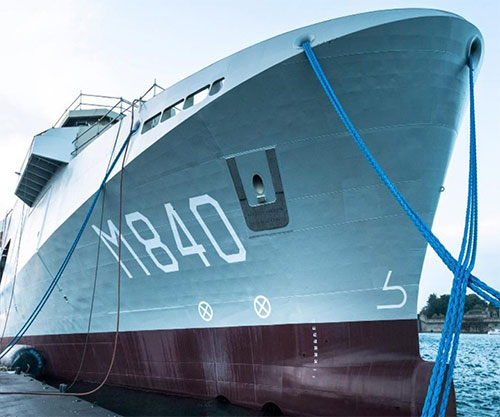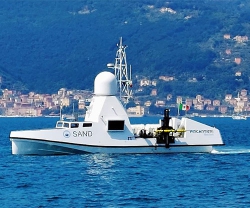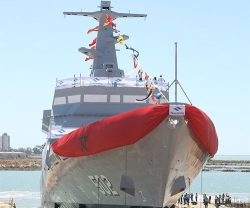The launching ceremony of the Vlissingen, second of the twelve mine countermeasure vessels of the Belgian-Dutch rMCM programme, intended for the Royal Netherlands Navy, took place on October 19th 2023 in Concarneau in the presence of the Chiefs of Navy of the Royal Netherlands Navy and the Belgian Navy, and the representative of the Chief of Staff of the French Navy.
The launching was carried out by Kership, which builds the ships in Concarneau on behalf of Naval Group, general contractor.
This programme was awarded in 2019 to Belgium Naval & Robotics, the consortium formed by Naval Group and Exail (new name of the alliance between ECA Group and iXblue), following an international competition. It provides for the supply to the Belgian Navy and the Royal Netherlands Navy of twelve mine countermeasures vessels and around a hundred drones integrated inside a toolbox that will equip the vessels.
Naval Group, as overall architect and prime contractor, is responsible for the design of the ships, the overall integration, and the testing and commissioning of the mission system (combat system and mine countermeasures system).
Kership, a joint venture between Naval Group and Piriou, is in charge of the production of the twelve vessels which are assembled in Concarneau and Lanester.
Exail, as co-contractor, is in charge of the unmanned drones’ system. Most of these drones will be produced in Ostend, Belgium. The maintenance of the ships will be carried out in Belgium in close collaboration between the Belgian Navy and Naval Group Belgium, with the assistance of its partner Flanders Ship Repair.
The Vlissingen, second vessel of the program and first one intended for the Royal Netherlands Navy, will be delivered in 2025.
The first vessel, Oostende, intended for the Belgian Navy, has been launched on March 29th 2023, while the keel for the third of the twelve vessels, the M941 Tournai, also intended for the Belgian Navy, was laid. The keel of the fourth vessel, the Scheveningen, second vessel intended for the Royal Netherlands Navy, was laid on July 19th 2023.
The delivery of the Oostende is scheduled for the end of 2024 in Zeebrugge, Belgium. Deliveries of the other vessels will then be staggered until 2030.
Pierre Eric Pommellet, CEO of Naval Group said: “This ship is once again the symbol of great industrial cooperation, but also that of great European cooperation. The Vlissingen is now launched less than 53 months after the contract came into force. This success is the fruit of the cooperative work of the engineering teams of Naval Group, the production teams of Kership and the Piriou shipyard, and the teams of the Belgian and Dutch administrations whom I would like to congratulate.”
The rMCM programme is also a major element of European Defence. This programme demonstrates that European countries can work together to define their needs and share a solution that is destined to become a reference in the mine countermeasures field, not only for the Belgian and Dutch navies, but also for other navies in Europe and around the world.
In September 2023, a Memorandum of Understanding (MoU) was signed between France, Belgium and the Netherlands. It allows France to use the rMCM vessels design to equip the French Navy. 12+6 vessels should be delivered under these programs. Thales, which since 2015 has been developing the Franco-British MMCM unmanned mine countermeasures programme, currently being tested at sea by the two Navies, will be in charge of the embedded drone solution for France. This partnership further solidifies the cooperation of these three countries in the field of mine warfare.
These specialised and cyber secured by design mine countermeasures (MCM) vessels are the first to have the capability to embark and launch a combination of surface drones (themselves 12-metre, 18 tonne vessels), underwater drones and aerial drones. The mine countermeasures vessels will use a mainly autonomous system for detection, classification and neutralisation of mines. They can withstand underwater explosions and have very low acoustic, electrical and magnetic signatures, in line with the missions to be carried out.
These mine countermeasure vessels have the following characteristics:
- Length: 82,6m
- Width: 17m
- Displacement: 2800t
- Maximum Speed: 15,3 knots
- Range: >3500 nautical miles
- Crew: 63 people (base crew 33 people)
- Drone Capabilities: Exail UMISOFT System, 2 unmanned surface vehicles (Exail Inspector 125), 3 autonomous underwater vehicles (A-18 equipped with Exail UMISAS 120 sonar), 2 towed sonars (T-18 equipped with Exail UMISAS 240 sonar), 2 Mine Identification & Disposal Systems (MIDS) systems (Exail Seascan and K-Ster C), 2 unmanned aerial vessel (UMS Skeldar’s V200), 1 Exail influence mine sweeping system integrating 5 CTM magnetic modules et 1 PATRIA acoustic module
- Embarkation Capacity: 2 SOLAS rigid hull inflatable boats of 7m
- Handling: 2 side launch & recovery systems for surface drones or commando boats, a 15t dedicated rear crane and a 3t overhead crane
Naval Group is a partner to its customers' maritime sovereignty. An international player in naval defense and heir to French naval know-how, Naval Group develops innovative solutions to meet the needs of navies. Present throughout the entire life cycle of the ships, the group designs, builds, integrates and maintains submarines and surface ships, as well as their systems and equipment, through to dismantling. It also provides services for shipyards and naval bases.
A high-tech company, Naval Group builds on its exceptional expertise, its unique design and production resources and its ability to set up strategic partnerships and successful transfers of technology. Attentive to the challenges of corporate social responsibility, Naval Group is a member of the United Nations Global Compact.
With operations on five continents, the group has a turnover of 4.3 billion euros and employs 16 029 people (full-time equivalents / 2022 data).





















